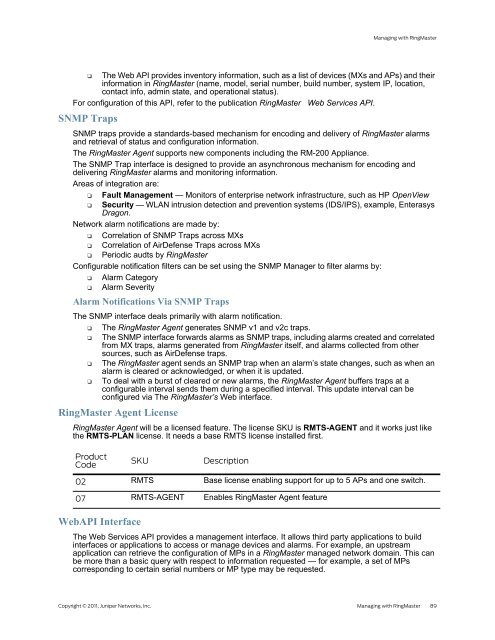RingMaster Management Guide - Juniper Networks
RingMaster Management Guide - Juniper Networks
RingMaster Management Guide - Juniper Networks
You also want an ePaper? Increase the reach of your titles
YUMPU automatically turns print PDFs into web optimized ePapers that Google loves.
Managing with <strong>RingMaster</strong><br />
❑ The Web API provides inventory information, such as a list of devices (MXs and APs) and their<br />
information in <strong>RingMaster</strong> (name, model, serial number, build number, system IP, location,<br />
contact info, admin state, and operational status).<br />
For configuration of this API, refer to the publication <strong>RingMaster</strong> Web Services API.<br />
SNMP Traps<br />
SNMP traps provide a standards-based mechanism for encoding and delivery of <strong>RingMaster</strong> alarms<br />
and retrieval of status and configuration information.<br />
The <strong>RingMaster</strong> Agent supports new components including the RM-200 Appliance.<br />
The SNMP Trap interface is designed to provide an asynchronous mechanism for encoding and<br />
delivering <strong>RingMaster</strong> alarms and monitoring information.<br />
Areas of integration are:<br />
❑ Fault <strong>Management</strong> — Monitors of enterprise network infrastructure, such as HP OpenView<br />
❑ Security — WLAN intrusion detection and prevention systems (IDS/IPS), example, Enterasys<br />
Dragon.<br />
Network alarm notifications are made by:<br />
❑ Correlation of SNMP Traps across MXs<br />
❑ Correlation of AirDefense Traps across MXs<br />
❑ Periodic audts by <strong>RingMaster</strong><br />
Configurable notification filters can be set using the SNMP Manager to filter alarms by:<br />
❑ Alarm Category<br />
❑ Alarm Severity<br />
Alarm Notifications Via SNMP Traps<br />
The SNMP interface deals primarily with alarm notification.<br />
❑ The <strong>RingMaster</strong> Agent generates SNMP v1 and v2c traps.<br />
❑ The SNMP interface forwards alarms as SNMP traps, including alarms created and correlated<br />
from MX traps, alarms generated from <strong>RingMaster</strong> itself, and alarms collected from other<br />
sources, such as AirDefense traps.<br />
❑ The <strong>RingMaster</strong> agent sends an SNMP trap when an alarm’s state changes, such as when an<br />
alarm is cleared or acknowledged, or when it is updated.<br />
❑ To deal with a burst of cleared or new alarms, the <strong>RingMaster</strong> Agent buffers traps at a<br />
configurable interval sends them during a specified interval. This update interval can be<br />
configured via The <strong>RingMaster</strong>’s Web interface.<br />
<strong>RingMaster</strong> Agent License<br />
<strong>RingMaster</strong> Agent will be a licensed feature. The license SKU is RMTS-AGENT and it works just like<br />
the RMTS-PLAN license. It needs a base RMTS license installed first.<br />
Product<br />
Code<br />
SKU Description<br />
02 RMTS Base license enabling support for up to 5 APs and one switch.<br />
07 RMTS-AGENT Enables <strong>RingMaster</strong> Agent feature<br />
WebAPI Interface<br />
The Web Services API provides a management interface. It allows third party applications to build<br />
interfaces or applications to access or manage devices and alarms. For example, an upstream<br />
application can retrieve the configuration of MPs in a <strong>RingMaster</strong> managed network domain. This can<br />
be more than a basic query with respect to information requested — for example, a set of MPs<br />
corresponding to certain serial numbers or MP type may be requested.<br />
Copyright © 2011, <strong>Juniper</strong> <strong>Networks</strong>, Inc. Managing with <strong>RingMaster</strong> 89

















